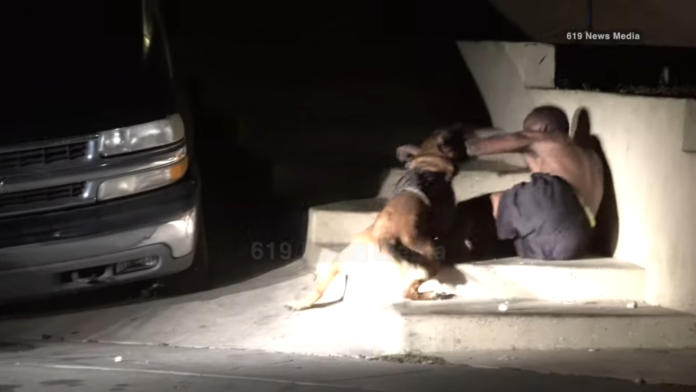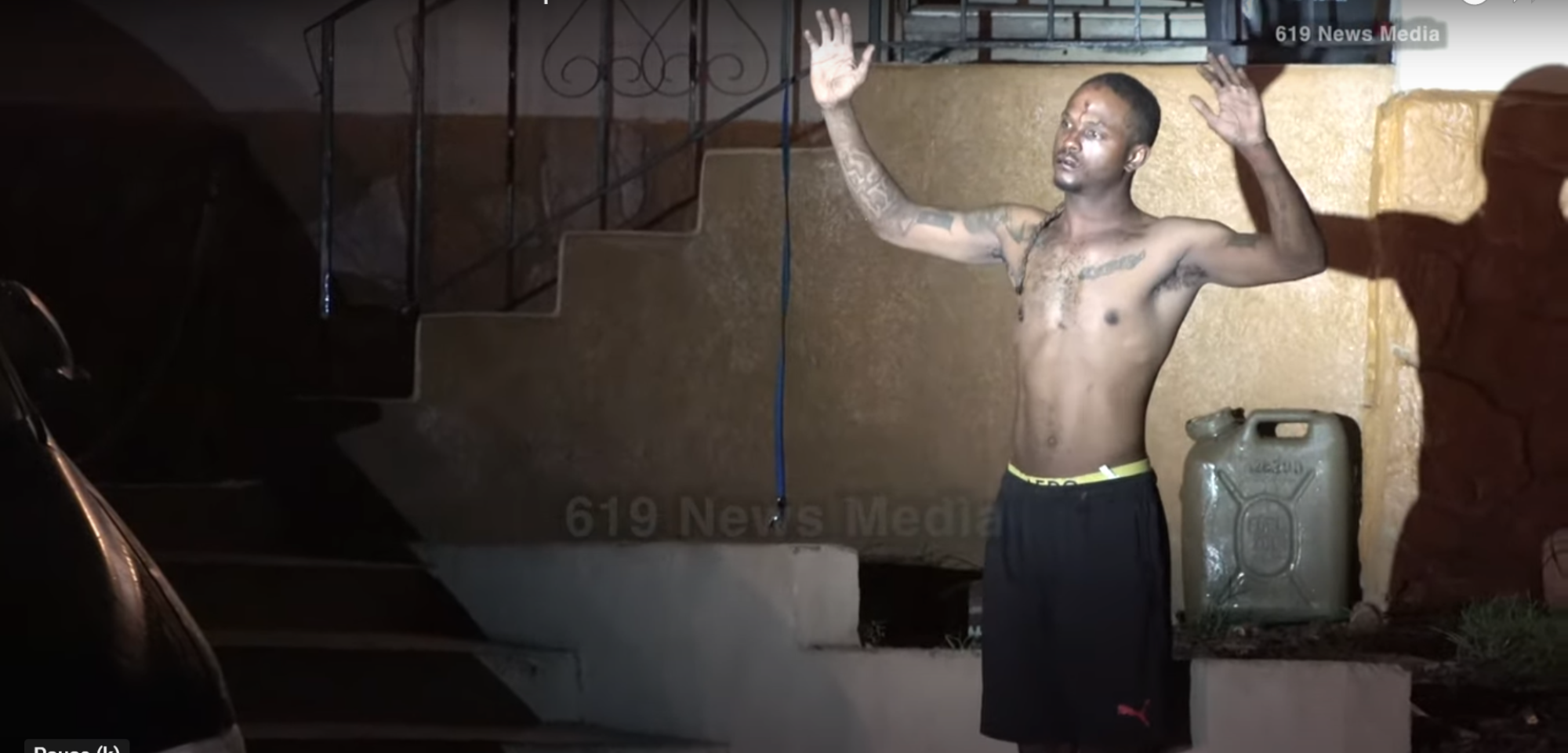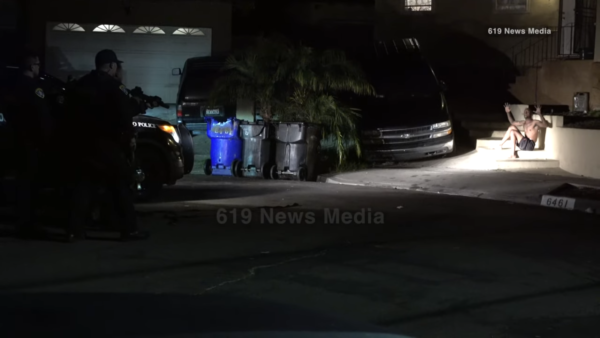
VOICE & VIEWPOINT NEWSWIRE
A formal complaint has been filed by an officer, John Cochran, of the San Diego Police Department, who submitted to his chain of command regarding the incident on Oct. 25 in which officers used excessive force (2-3 bean bag rounds and 2 K9 dogs deployed) on an unarmed Black man identified as Marcus Evans. Officers knew Evans was unarmed and not evading detention or arrest, wearing only basketball shorts with no shoes, socks, or a shirt.
The community is demanding the officers be put on administrative leave pending the investigation and the Attorney General step in to monitor and review.
The citizen’s complaint was filed by San Diego Police Officer John Cochran, addressed to Chief of Police Scott Wahl. His letter reads as follows:
In compliance with my duty to report misconduct brought to my attention, San Diego Police Department (SDPD) Policy 9.33 DUTY TO REPORT MISCONDUCT POLICY, Tasha Williamson, a community activist, sent me a video from “619 News Media,” which can be viewed on Instagram. The video showed a black male whom Mrs. Williamson referred to as Marcus Evans, being arrested by several San Diego Police Officers. I took the time to do more research and discovered a longer version of the arrest on “619 News Media,” which can be viewed on YouTube.
Mrs. Williamson believes the SDPD officers who was involved in the arrest of Marcus Evans used excessive force. After watching the video, I agree with Mrs. Williamson’s conclusion the force used to arrest Marcus Evans was excessive.
It is printed on the video that the San Diego Police Department responded to the area because someone displayed a firearm during an altercation. Several people were given orders by police to exit the house and then police directed them to hold up their hands. Several people came out of the house and they all complied with the officer’s orders.
I will refer to the next community member who came out of the house as Marcus. Marcus exited the house and was ordered to raise his hands. Marcus raised his hands and then walked down the stairs as ordered by police. Marcus was wearing a black loosely fitted sports shorts. Marcus was not wearing a shirt, socks, or shoes.

When Marcus reached the bottom of the stairs, he stopped but continued to hold his hands up. Marcus asked the officers why they were at his home. The officer spoke because “A gun was involved.” Marcus sat on a retaining wall and then crossed his arms in front of his body. At some point during the contact the police officer asked Marcus to turn around to check him for any visible weapons. Marcus complied with the order to turn around.
Clearly Marcus was not armed. Marcus told the officer he had not did anything wrong. Marcus sat on the wall but did not comply with the officer request for him to come towards them. Marcus sat on the retaining wall with his hands in front of his body.
San Diego Police Department Procedure 1.04 Use of Force: IV. Section L, page 3 of 13.
Passive Resistance – behavior that consists of a refusal to comply with verbal commands and does not convey a threat of physical resistance to the officer or another person.
Marcus’s behavior was consistent with SDPD procedure definition of passive resistance. An officer using a beanbag, or a K-9 on a person who behavior is consistent with passive behavior, is in violation of SDPD Use of Force procedure Page 13 of 13.
Someone might attempt to describe Marcus’s behavior as active resistance. SDPD Use of Force procedure describes Active Resistance as follows:
Active Resistance – Physically evasive movements to defeat an officer’s attempt at control, including bracing, tensing, running away or verbally signaling an intention to avoid or prevent being taken into or retained in custody.
Marcus was sitting on the wall when he was initially shot in the abdomen with a beanbag round. Marcus was shot a second time with a beanbag round while he sat on the ground. Marcus was attacked by a police dog twice while sitting on the ground with his hands raised with no access to a weapon.

Therefore, SDPD procedure V.D. page 6 of 13. Is not applicable, which states as follows:
The use of canines, Tasers, extended range impact weapons, and standard impact weapon techniques may be used to control an actively resisting subject reasonably believed to possess, or have immediate access to, a deadly weapon.
It appears to me the officer who fired the second bean bag round possible intentionally aimed the round at Marcus’s groin area. In violation of SDPD procedure 1.38 – Kinetic Energy Weapon Systems, section V. E. which states as follows:
The target area from all distances should be the lower girdle area of the subject. This would include the lower abdominal region (belly button area) and below. Generally, the head, neck, thorax, heart, groin, and spine area should not be targeted.
All the supervisors at that scene had a duty to intervene after Marcus was shot the first time with a beanbag in violation of Use of Force, per SDPD Procedure 1.56 – Intervention Duties Section V. A. Page 2 of 2.
Any officer who is present and observes another officer using force that is clearly beyond that which is necessary, as determined by an objectively reasonable officer under the circumstances, taking into account the possibility that the other officers may have additional information regarding the threat posed by the subject, shall, when in a position to do so, intervene to prevent the use of unreasonable force.
It appears from reviewing the video that any supervisor at the scene is in violation of their duty to intervene.
These types of atrocious acts allowed to occur without accountability, can cause a city to be liable. Just like the La Mesa officer actions caused the City of La Mesa to pay $10 million to the woman hit in the head by a police beanbag during a protest.
- Cops Allow Police Dog to Bite Naked, Unarmed Man (SDPD): City of San Diego settles for $385,000
- Graphic Video Shows Police Dog Refusing to Release Handcuffed Man’s Arm
San Diego Police Department procedure, 1.55 – De-Escalation Section III, G. page 2 of 5, states:
The process of incident management and de-escalation includes, but is not limited to, the following:
1. Utilizing pre-engagement techniques
2. Assessing the overall scene
3. Establishing effective lines of communication
4. Using appropriate levels of reasonable force, based on the totality of the circumstances
5. Intervening whenever force being used appears unreasonable
6. Rendering aid and evaluating the need for medical assistance
7. Reporting of all force used during the incident
8. Reviewing the incident to ensure adherence to department procedures.
When I spoke with you during the meeting we had on October 16, 2024, I told you if you could not get officers to act professional in a line-up, you will never be able to get them to be professional out in the field with community members. In reference to the behavior displayed by officers during the line-up video conference, which I reported to you via email on September 16, 2024. SDPD management failure to maintain a non-hostile work environment internally correlates with the atrocious behavior of the officers and supervisors, during the arrest of Marcus.
Conclusion:
Mrs. Williamson is concerned for the safety of the public. The San Diego Police Department supervision, training and checks and balance to prevent unreasonable and excessive use of force, failed. Due to the officer’s flagrant disregard of law and SDPD policy and procedures, Mrs. Williamson is requesting, all officers involved in the arrest of Marcus be removed from working all assignments having access to the public immediately and until all “Formal” investigations of this matter has concluded.
-John Cochran, Police Officer III



